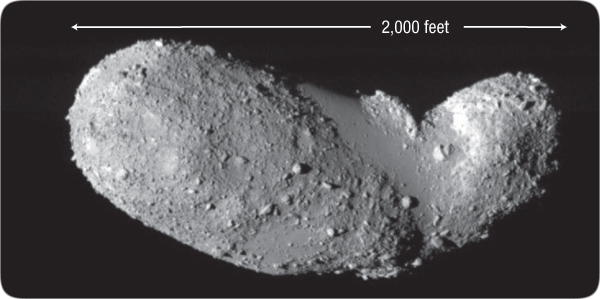As opposed to you? All you do is thread-crap. You have nothing at all to contribute but you need attention so badly that you cannot shut your hole. Pathetic
:first:
As opposed to you? All you do is thread-crap. You have nothing at all to contribute but you need attention so badly that you cannot shut your hole. Pathetic
"thread crapping"? Hardly. The OP claims Pastor Bob stated that there was a connection all based on Walt Brown's work. It appears he is wrong. Think he will step up and admit it? Not likely. Brown is one of his favorites.
How do I turn heat into kinetic energy?

| Asteroid Itokawa (e-toe-KA-wah). The fountains expelled dirt, rocks, and considerable water from Earth. About half of that water quickly evaporated into the vacuum of space, freezing the remainder. Each evaporated gas molecule became an orbiting body in the solar system. Later asteroids formed. Many are shaped like peanuts. Gas molecules captured by asteroids or released by icy asteroids became their temporary atmospheres. Asteroids with thick atmospheres sometimes captured smaller asteroids as moons. If an atmosphere remained long enough, those moons would lose altitude and gently merge gravitationally with their asteroids, forming peanut-shaped asteroids. If an atmosphere dissipates before merging, a moon remains. We see merging (called aero-braking) when a satellite or spacecraft re-enters Earth’s atmosphere, slowly loses altitude, and falls to (merges with) Earth. Without an atmosphere, merging in space becomes almost impossible. Japan’s Hayabusa spacecraft traveled alongside asteroid Itokawa for two months in 2005. Scientists studying Itokawa concluded that it consists of two smaller asteroids that merged. Donald Yeomans, a mission scientist and member of NASA’s Jet Propulsion Laboratory, admitted, “It’s a major mystery how two objects each the size of skyscrapers could collide without blowing each other to smithereens. This is especially puzzling in a region of the solar system where gravitational forces would normally involve collision speeds of 2 km/sec [4,500 miles per hour]. The mystery is solved when one understands the gentle role that water (and the gases produced) played in the origin of comets and asteroids. Notice that a myriad of rounded boulders, some 150 feet in diameter, litter Itokawa’s surface. High velocity water produces rounded boulders; an exploded planet or impacts on asteroids would produce angular rocks. The Hayabusa spacecraft landed on asteroid Itokawa, scooped up 1534 tiny rocks (up to 0.18 millimeters in diameter) and returned them to Earth in 2010. The wide range of minerals in those rocks were typical of Earth’s most common minerals, but their chemical elements were quite different from the solar system’s most common chemical elements. Analyses of Itokawa’s minerals show that at some time in the distant past, they reached temperatures of up to 1472°F, which would have been typical of the rocks in the subterranean chambers. Average temperatures on the asteroid itself are about 1,900°F colder! |
^ Perhaps the Professor can elaborate the point he wishes to make by posting this extended C&P?
We can talk about any issue you like. My link was in line with what were were talking about. Feel free to comment upon it.I think he was trying to avoid mentioning the unusually high O18/O16 and O17/O16 isotope ratios, which are entirely inconsistent with an Earthly origin of the asteroid. Unless the hydroplane theory has an ad hoc explanation for differentiation by isotope?
Comment on what, Professor? The argument you have omitted to make which your C&P was intended to illustrate?We can talk about any issue you like. My link was in line with what were were talking about. Feel free to comment upon it.
My comment, Stripe, is that the cut'n'paste says that the chemical elements found were typical of those on Earth, but that is reality that is not true. The isotope ratios are waaay wrong. Hence, they're are not from Earth. (wasn't that pretty much what I've said already?)
And we're talking about something else at the moment.
Feel free to comment upon what we are discussing at present. :up:
So what are we 'discussing at present' and how was your C&P intended to advance it? Given that this C&P includes references to the chemical composition of the asteroid and its alleged similarity to Earth, GCT's observation seems entirely pertinent. If you find this obvious discrepancy embarrassing for Wally's hypothesis, perhaps you shouldn't have posted something that led to it being introduced into the discussion?And we're talking about something else at the moment.
Feel free to comment upon what we are discussing at present. :up:
Clearly you can only comment on things that the Professor allows you to. It's a professor's prerogative, after all.So I shouldn't comment on the material you cut'n'pasted? Huh?! You should stop smoking whatever is doing this to you.
Clearly you can only comment on things that the Professor allows you to. It's a professor's prerogative, after all.
I guess if the cognitive dissonance gets too great, you're forced into defending anything that seems to reduce the dissonance. So when he says 'We can talk about any issue you like' what he actually means is anything except what he doesn't want you to.Why do you think he feels the need to defend every anti-science crackpot theory at comes up in Enyart's show? Is Enyart's show like the inerrant declarations of dogma the Pope makes?
In other news ...
You are in France (French?): will you be watching the England-France rugby match is afternoon?
You can comment on whatever you like. But we were having a specific discussion. Feel free to join it. :up:So I shouldn't comment on the material you cut'n'pasted? Huh?! You should stop smoking whatever is doing this to you.
You can comment on whatever you like. But we were having a specific discussion. Feel free to join it. :up:
What are we talking about?
The French play rugby? It's said that it's a game for ruffians, played by gentlemen.
Which should disqualify the French on both counts.
